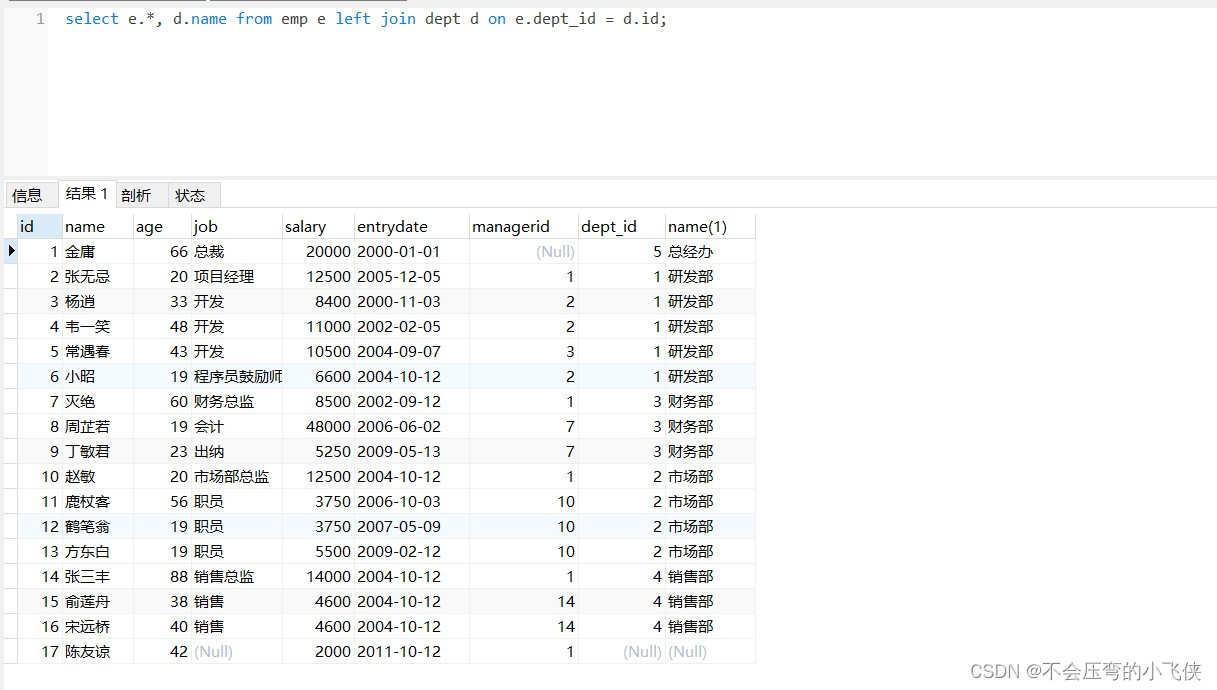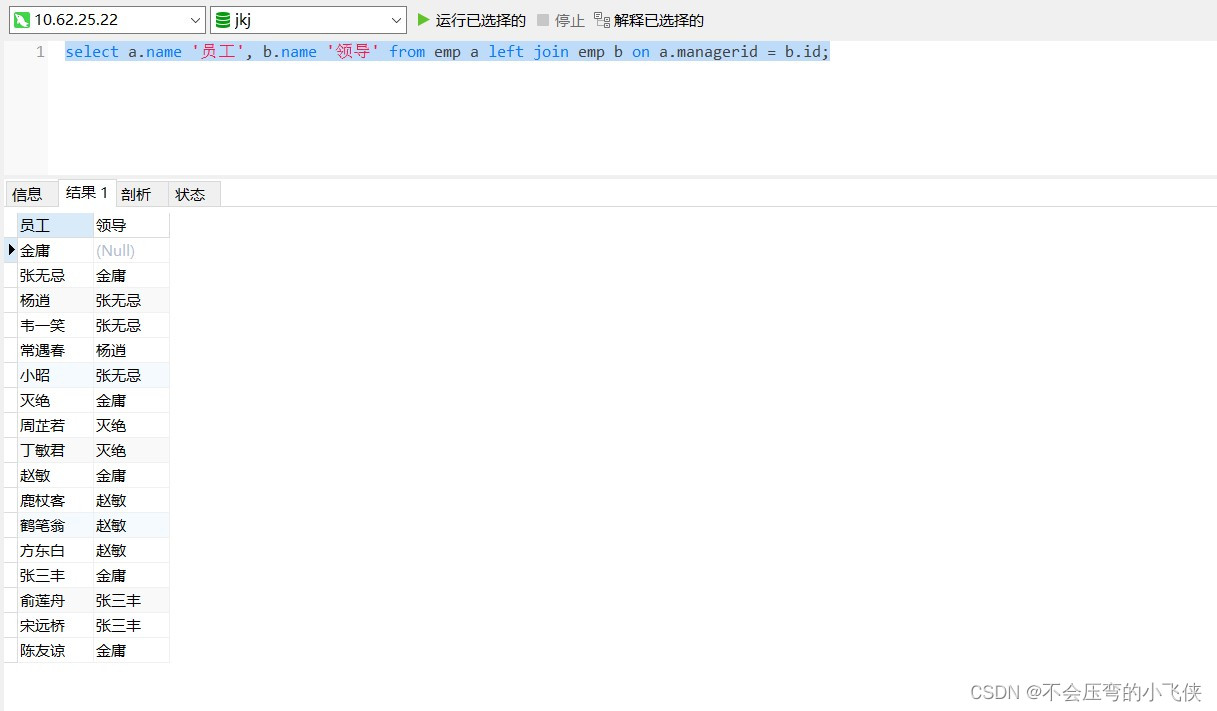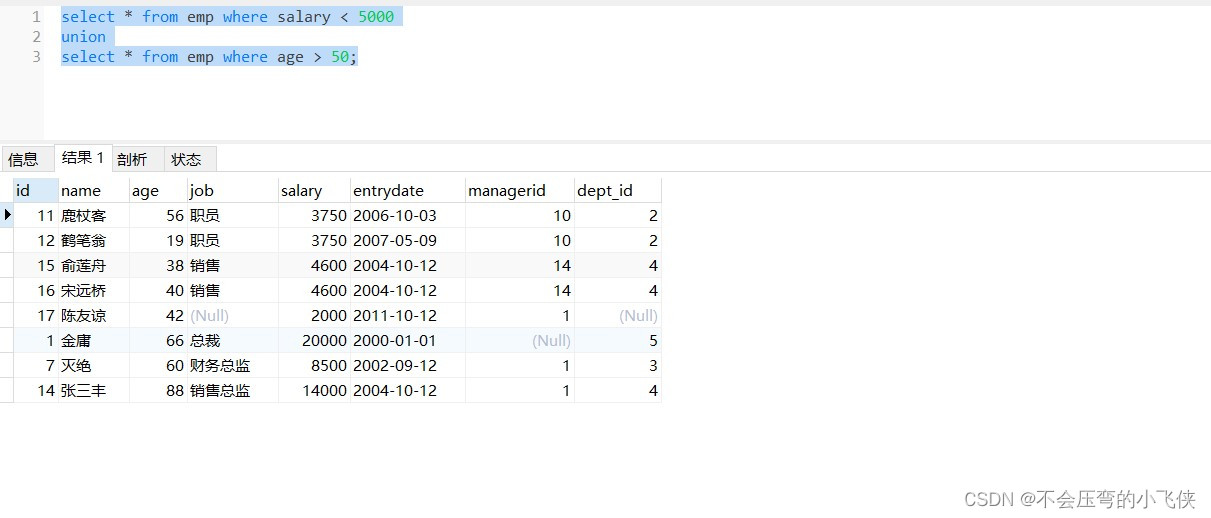【MySQL数据库】- 多表查询
短信预约 -IT技能 免费直播动态提醒

🍁博客主页:👉@不会压弯的小飞侠
✨欢迎关注:👉点赞👍收藏⭐留言✒
✨系列专栏:👉MySQL数据库专栏
✨欢迎加入社区:👉不会压弯的小飞侠
✨人生格言:知足上进,不负野心。
🔥欢迎大佬指正,一起学习!一起加油!

目录
- 项目开发中,在进行数据库表结构设计时,会根据业务需求及业务模块之间的关系,分析并设计表结构,由于业务之间相互关联,所以各个表结构之间也存在着各种联系。
- 基本上分为三种:
- 一对多(多对一)
- 多对多
- 一对一
🍁一对多
- 案例: 部门 与 员工的关系
- 关系: 一个部门对应多个员工,一个员工对应一个部门
- 实现: 在多的一方建立外键,指向一的一方的主键

🍁多对多
- 案例: 学生 与 课程的关系
- 关系: 一个学生可以选修多门课程,一门课程也可以供多个学生选择
- 实现: 建立第三张中间表,中间表至少包含两个外键,分别关联两方主键

- 代码部分
create table student( id int auto_increment primary key comment '主键ID', name varchar(10) comment '姓名', no varchar(10) comment '学号') comment '学生表';insert into student values (null, '黛绮丝', '2000100101'),(null, '谢逊', '2000100102'),(null, '殷天正', '2000100103'),(null, '韦一笑', '2000100104');create table course( id int auto_increment primary key comment '主键ID', name varchar(10) comment '课程名称') comment '课程表';insert into course values (null, 'Java'), (null, 'PHP'), (null , 'MySQL') , (null, 'Hadoop');create table student_course( id int auto_increment comment '主键' primary key, studentid int not null comment '学生ID', courseid int not null comment '课程ID', constraint fk_courseid foreign key (courseid) references course (id), constraint fk_studentid foreign key (studentid) references student (id))comment '学生课程中间表';insert into student_course values (null,1,1),(null,1,2),(null,1,3),(null,2,2),(null,2,3),(null,3,4);🍁一对一
- 案例: 用户 与 用户详情的关系
- 关系: 一对一关系,多用于单表拆分,将一张表的基础字段放在一张表中,其它详情字段放在另一张表中,以提升操作效率
- 实现: 在任意一方加入外键,关联另外一方的主键,并且设置外键为唯一的(UNIQUE)

- 代码部分
create table tb_user( id int auto_increment primary key comment '主键ID', name varchar(10) comment '姓名', age int comment '年龄', gender char(1) comment '1: 男 , 2: 女', phone char(11) comment '手机号') comment '用户基本信息表';create table tb_user_edu( id int auto_increment primary key comment '主键ID', degree varchar(20) comment '学历', major varchar(50) comment '专业', primaryschool varchar(50) comment '小学', middleschool varchar(50) comment '中学', university varchar(50) comment '大学', userid int unique comment '用户ID', constraint fk_userid foreign key (userid) references tb_user(id)) comment '用户教育信息表';insert into tb_user(id, name, age, gender, phone) values (null,'黄渤',45,'1','18800001111'), (null,'冰冰',35,'2','18800002222'), (null,'码云',55,'1','18800008888'), (null,'李彦宏',50,'1','18800009999');insert into tb_user_edu(id, degree, major, primaryschool, middleschool, university, userid) values (null,'本科','舞蹈','静安区第一小学','静安区第一中学','北京舞蹈学院',1), (null,'硕士','表演','朝阳区第一小学','朝阳区第一中学','北京电影学院',2), (null,'本科','英语','杭州市第一小学','杭州市第一中学','杭州师范大学',3), (null,'本科','应用数学','阳泉第一小学','阳泉区第一中学','清华大学',4);- 多表查询就是指从多张表中查询数据。
- 原来查询单表数据,执行的SQL形式为:select * from emp;
- 那么我们要执行多表查询,就只需要使用逗号分隔多张表即可,如: select * from emp , dept;
- 1.创建emp表并插入测试数据
--创建deptcreate table emp( id int auto_increment comment 'ID' primary key, name varchar(50) not null comment '姓名', age int comment '年龄', job varchar(20) comment '职位', salary int comment '薪资', entrydate date comment '入职时间', managerid int comment '直属领导ID', dept_id int comment '部门ID')comment '员工表';--插入数据INSERT INTO emp (id, name, age, job,salary, entrydate, managerid, dept_id) VALUES (1, '金庸', 66, '总裁',20000, '2000-01-01', null,5), (2, '张无忌', 20, '项目经理',12500, '2005-12-05', 1,1), (3, '杨逍', 33, '开发', 8400,'2000-11-03', 2,1), (4, '韦一笑', 48, '开发',11000, '2002-02-05', 2,1), (5, '常遇春', 43, '开发',10500, '2004-09-07', 3,1), (6, '小昭', 19, '程序员鼓励师',6600, '2004-10-12', 2,1), (7, '灭绝', 60, '财务总监',8500, '2002-09-12', 1,3), (8, '周芷若', 19, '会计',48000, '2006-06-02', 7,3), (9, '丁敏君', 23, '出纳',5250, '2009-05-13', 7,3), (10, '赵敏', 20, '市场部总监',12500, '2004-10-12', 1,2), (11, '鹿杖客', 56, '职员',3750, '2006-10-03', 10,2), (12, '鹤笔翁', 19, '职员',3750, '2007-05-09', 10,2), (13, '方东白', 19, '职员',5500, '2009-02-12', 10,2), (14, '张三丰', 88, '销售总监',14000, '2004-10-12', 1,4), (15, '俞莲舟', 38, '销售',4600, '2004-10-12', 14,4), (16, '宋远桥', 40, '销售',4600, '2004-10-12', 14,4), (17, '陈友谅', 42, null,2000, '2011-10-12', 1,null);- 2.创建dept表并插入测试数据
--创建deptcreate table dept( id int auto_increment comment 'ID' primary key, name varchar(50) not null comment '部门名称')comment '部门表';--插入数据INSERT INTO dept (id, name) VALUES (1, '研发部'), (2, '市场部'),(3, '财务部'), (4, '销售部'), (5, '总经办'), (6, '人事部');- 3.添加外键
alter table emp add constraint fk_emp_dept_id foreign key (dept_id) references dept(id);- 笛卡尔乘积是指在数学中,两个集合A集合 和 B集合的所有组合情况。
- 而在多表查询中,是需要消除无效的笛卡尔积的,只保留两张表关联部分的数据。在SQL语句中可以给多表查询加上连接查询的条件即可。
select * from emp , dept where emp.dept_id = dept.id;
- 注意:
- 而由于id为17的员工,没有dept_id字段值,所以在多表查询时,根据连接查询的条件并没有查询到。
- 相当于查询A、B交集部分数据
- 内连接的语法分为两种: 隐式内连接、显式内连接。
🍁隐式内连接
- 1.语法格式:
SELECT 字段列表 FROM 表1 , 表2 WHERE 条件 ... ;- 2.案例:
- 查询每一个员工的姓名 , 及关联的部门的名称 (隐式内连接实现)
- 表结构: emp , dept
- 连接条件: emp.dept_id = dept.id
- 代码实现:
select emp.name , dept.name from emp , dept where emp.dept_id = dept.id ;--起别名select e.name,d.name from emp e , dept d where e.dept_id = d.id;
🍁显式内连接
- 1.语法格式:
SELECT 字段列表 FROM 表1 [ INNER ] JOIN 表2 ON 连接条件 ... ;- 2.案例:
- 查询每一个员工的姓名 , 及关联的部门的名称 (显式内连接实现) INNER JOIN … ON …
- 表结构: emp , dept
- 连接条件: emp.dept_id = dept.id
- 代码实现:
select e.name, d.name from emp e inner join dept d on e.dept_id = d.id;---inner可以省略select e.name, d.name from emp e join dept d on e.dept_id = d.id;
- 外连接分为两种,分别是:左外连接 和 右外连接。
🍁左外连接
- 1.查询左表所有数据,以及两张表交集部分数据
- 2.左外连接相当于查询表1(左表)的所有数据,当然也包含表1和表2交集部分的数据。
- 3.语法格式
SELECT 字段列表 FROM 表1 LEFT [ OUTER ] JOIN 表2 ON 条件 ... ;- 4.案例:
- 查询emp表的所有数据, 和对应的部门信息
- 由于需求中提到,要查询emp的所有数据,所以是不能内连接查询的,需要考虑使用外连接查询。
- 表结构: emp, dept
- 连接条件: emp.dept_id = dept.id
select e.*, d.name from emp e left outer join dept d on e.dept_id = d.id;---省略outerselect e.*, d.name from emp e left join dept d on e.dept_id = d.id;
🍁右外连接
- 1.查询右表所有数据,以及两张表交集部分数据
- 2.右外连接相当于查询表2(右表)的所有数据,当然也包含表1和表2交集部分的数据。
- 3.语法格式
SELECT 字段列表 FROM 表1 RIGHT [ OUTER ] JOIN 表2 ON 条件 ... ;- 4.案例:
- 查询dept表的所有数据, 和对应的员工信息(右外连接)
- 由于需求中提到,要查询dept表的所有数据,所以是不能内连接查询的,需要考虑使用外连接查询。
- 表结构: emp, dept
- 连接条件: emp.dept_id = dept.id
select d.*, e.* from emp e right outer join dept d on e.dept_id = d.id;---省略outerselect e.*, d.name from emp e right join dept d on e.dept_id = d.id;
- 1.自连接查询,顾名思义,就是自己连接自己,也就是把一张表连接查询多次。
- 2.当前表与自身的连接查询,自连接必须使用表别名
- 3.而对于自连接查询,可以是内连接查询,也可以是外连接查询。
- 4.查询语法
SELECT 字段列表 FROM 表A 别名A JOIN 表A 别名B ON 条件 ... ;- 5.案例
- 查询员工 及其 所属领导的名字
- 表结构: emp
select a.name , b.name from emp a , emp b where a.managerid = b.id;
- 查询所有员工 emp 及其领导的名字 emp , 如果员工没有领导, 也需要查询
- 出来表结构: emp a , emp b
select a.name '员工', b.name '领导' from emp a left join emp b on a.managerid = b.id;
- 1.对于union查询,就是把多次查询的结果合并起来,形成一个新的查询结果集。
- 2.对于联合查询的多张表的列数必须保持一致,字段类型也需要保持一致。
- 3.union all 会将全部的数据直接合并在一起,union 会对合并之后的数据去重。
- 4.语法格式
SELECT 字段列表 FROM 表A ...UNION [ ALL ]SELECT 字段列表 FROM 表B ....;- 5.案例
- 5.1将薪资低于 5000 的员工 , 和 年龄大于 50 岁的员工全部查询出来,可以直接使用多条件查询,使用逻辑运算符 or 连接即可。也可以通过union/union all来联合查询
select * from emp where salary < 5000union allselect * from emp where age > 50;
- 5.2union all查询出来的结果,仅仅进行简单的合并,并未去重。
select * from emp where salary < 5000unionselect * from emp where age > 50;
- 注意:union 联合查询,会对查询出来的结果进行去重处理。
- 5.3如果多条查询语句查询出来的结果,字段数量不一致,在进行union/union all联合查询时,将会报错
select * from emp where salary < 5000unionselect name from emp where age > 50;
- SQL语句中嵌套SELECT语句,称为嵌套查询,又称子查询。
- 子查询外部的语句可以是INSERT / UPDATE / DELETE / SELECT 的任何一个。
🍁分类
- 根据子查询结果不同,分为:
- 标量子查询(子查询结果为单个值)
- 列子查询(子查询结果为一列)
- 行子查询(子查询结果为一行)
- 表子查询(子查询结果为多行多列)
- 根据子查询位置,分为:
- WHERE之后
- FROM之后
- SELECT之后
🍁标量子查询
- 1.子查询返回的结果是单个值(数字、字符串、日期等),最简单的形式,这种子查询称为标量子查询。
- 常用的操作符:= <> > >= < <=
- 2.案例:
- 2.1查询 “销售部” 的所有员工信息,完成这个需求时,可以将需求分解为两步:
- 1.查询 “销售部” 部门ID
select id from dept where name = '销售部';
- 2.根据 “销售部” 部门ID, 查询员工信息
select * from emp where dept_id = (select id from dept where name = '销售部');
- 2.2查询在 “方东白” 入职之后的员工信息,完成这个需求时,可以将需求分解为两步:
- 1.查询 方东白 的入职日期
select entrydate from emp where name = '方东白';
- 2.查询指定入职日期之后入职的员工信息
select * from emp where entrydate > (select entrydate from emp where name = '方东白');
🍁列子查询
- 1.子查询返回的结果是一列(可以是多行),这种子查询称为列子查询。
- 常用的操作符:IN 、NOT IN 、 ANY 、SOME 、 ALL

- 2.案例:
- 2.1查询 “销售部” 和 “市场部” 的所有员工信息
- 分解为以下两步:
- 1.查询 “销售部” 和 “市场部” 的部门ID
select id from dept where name = '销售部' or name = '市场部';
- 2.根据部门ID, 查询员工信息
select * from emp where dept_id in (select id from dept where name = '销售部' or name = '市场部');
- 2.2查询比 财务部 所有人工资都高的员工信息
- 分解为以下两步:
- 1.查询所有 财务部 人员工资
select id from dept where name = '财务部';select salary from emp where dept_id = (select id from dept where name = '财务部');
- 2.比财务部所有人工资都高的员工信息
select * from emp where salary > all ( select salary from emp where dept_id = (select id from dept where name = '财务部') );- 2.3查询比研发部其中任意一人工资高的员工信息
- 分解为以下两步:
- 1.查询研发部所有人工资
select salary from emp where dept_id = (select id from dept where name = '研发部');
- 2.比研发部其中任意一人工资高的员工信息
select * from emp where salary > some ( select salary from emp where dept_id = (select id from dept where name = '研发部') );
🍁行子查询
- 1.子查询返回的结果是一行(可以是多列),这种子查询称为行子查询。
- 常用的操作符:= 、<> 、IN 、NOT IN
- 2.案例
- 2.1查询 “张无忌” 的薪资及直属领导
select salary, managerid from emp where name = '张无忌';
- 2.2查询与 “张无忌” 的薪资及直属领导相同的员工信息 ;
select * from emp where (salary,managerid) = (select salary, managerid from emp where name = '张无忌');
🍁 表子查询
- 1.子查询返回的结果是多行多列,这种子查询称为表子查询。
- 常用的操作符:IN
- 2.案例
- 2.1查询与 “鹿杖客” , “宋远桥” 的职位和薪资相同的员工信息
- 1.查询 “鹿杖客” , “宋远桥” 的职位和薪资
select job, salary from emp where name = '鹿杖客' or name = '宋远桥';
- 2.查询与 “鹿杖客” , “宋远桥” 的职位和薪资相同的员工信息
select * from emp where (job,salary) in ( select job, salary from emp where name = '鹿杖客' or name = '宋远桥' );
- 2.2查询入职日期是 “2006-01-01” 之后的员工信息 , 及其部门信息
- 1.入职日期是 “2006-01-01” 之后的员工信息
select * from emp where entrydate > '2006-01-01';
- 2.查询这部分员工, 对应的部门信息;
select e.*, d.* from (select * from emp where entrydate > '2006-01-01') e left join dept d on e.dept_id = d.id ;

来源地址:https://blog.csdn.net/qq_43514330/article/details/126807710
免责声明:
① 本站未注明“稿件来源”的信息均来自网络整理。其文字、图片和音视频稿件的所属权归原作者所有。本站收集整理出于非商业性的教育和科研之目的,并不意味着本站赞同其观点或证实其内容的真实性。仅作为临时的测试数据,供内部测试之用。本站并未授权任何人以任何方式主动获取本站任何信息。
② 本站未注明“稿件来源”的临时测试数据将在测试完成后最终做删除处理。有问题或投稿请发送至: 邮箱/279061341@qq.com QQ/279061341











![[mysql]mysql8修改root密码](https://static.528045.com/imgs/17.jpg?imageMogr2/format/webp/blur/1x0/quality/35)








